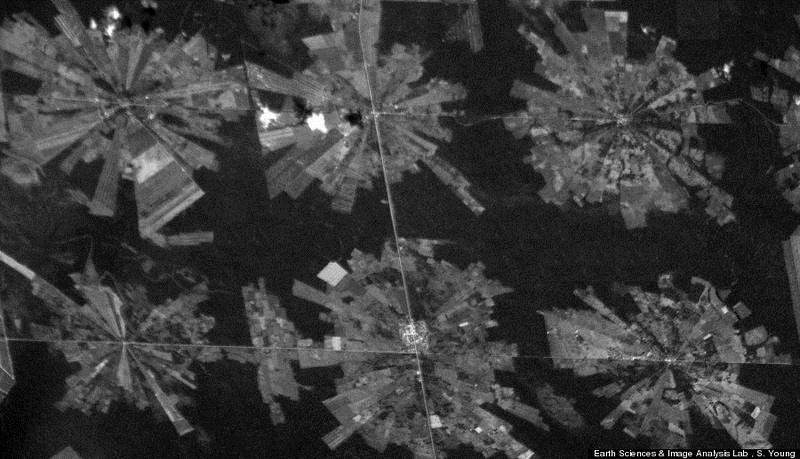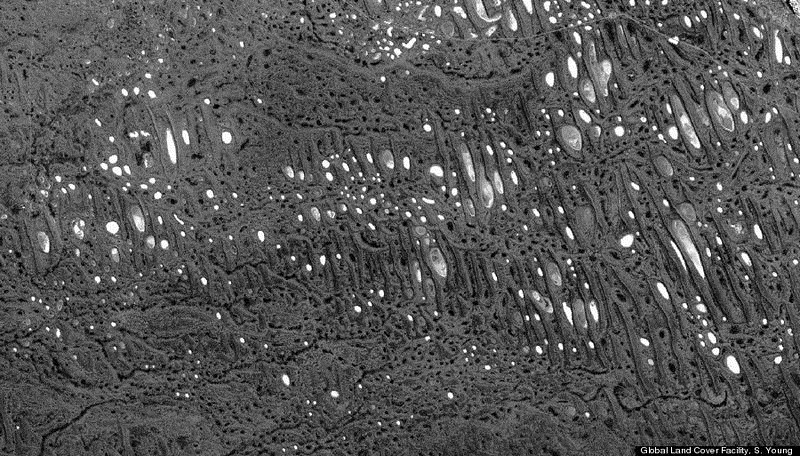While going through my daily reading list, one particular image posted on the Tumblr blog Daily Overview, which publishes high quality satellite photos of interesting places, grabbed my attention. At first I thought it was an integrated circuit, until I read the description, which said:
Colorful, metal-roofed industrial buildings line the coast of Tokai, Japan. The city’s economy is dominated by a massive steel mill - a portion of which is seen at the bottom of this Overview.
I was struck by how similar the satellite image looked to a close-up photo of an integrated circuit. You can check this out in the comparison published below. The image on the left is taken from the satellite and the image on the right is that of Intel’s Pentium 4 processor. The colors seen in the photograph of the processor are the actual colors produced by the diffraction/refraction of the light illuminating the die.

A similar discovery was made by Stephen Young and Paul Kelly, both science professors at Salem State University. Young is a geography professor studying vegetation change on Earth using satellite imagery, and Kelly is a herpetologist who studies snakes’ scales under a microscope to determine which species are closely related evolutionarily.
A few years ago, Dr. Young noticed some of the electron microscopic images Kelly created and thought that a few of them looked like landscapes. As a joke, he took one of his own landscape image of dunes in the Sahara and put them on Kelly’s door tricking him into believing that it was an electron microscopic image. This got the two talking and comparing imagery.
“We found that we had this similar interest in understanding scale and how people perceive it,” Young said to Smithsonian Magazine.
The two scientists have since been collecting puzzling images that are difficult to tell apart.
"Some patterns appear to repeat themselves in nature," explained Dr. Young to Huffington Post. "The study of fractals has shown this for some patterns, where, as you zoom in, the same pattern repeats itself. Also, there is nothing in the image to provide you with a measure of scale and so it is all shape and pattern. Shape and pattern do not define size."

A close-up of the wing of a Green Darner dragonfly.

A close-up of a crystal of sodium chloride or table salt.

A satellite image of North Africa.

A satellite image of deforestation in eastern Bolivia.

A satellite image of Western Australia.

A satellite photograph of dune patterns in Algeria.

An image of bone from an Atlantic Sturgeon.

A satellite image of northern Siberia.

A scanning electron microscope image of the surface of a piece of polished aluminum.

A false-color satellite image of sea-ice in the Weddell Sea. Reddish regions indicate thick ice.



It reminds me of a UFO investigator I saw who thought ancient pyramid structures when viewed far from above looked like integrated circuits. he thought they were giant computers and called them "macrochip technology" (unrelated from Sun Microsystem's laser CPU project, of course, but I couldn't find anything on the Web about it, and search engines kept reverting to "microchip" instead since they know what I meant to type :P
ReplyDeleteThis article reminds me of a book I have which is called "Heaven & Earth: Unseen By The Naked Eye" by Katherine Roucoux. The book starts with photographs of the smallest particles, all the way up to photographs taken in space of stars and galaxies (with everything else in-between), and when looking at the first few pictures and the last ones side by side, you can no longer tell if you're looking at a picture taken at the 'sub-atomic' level or at a picture of space. Absolutely fantastic images putting our human scale and existence into perspective.
ReplyDelete